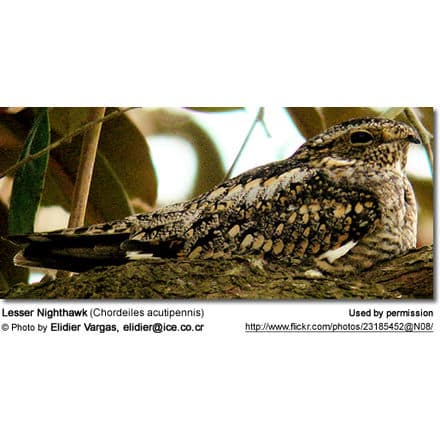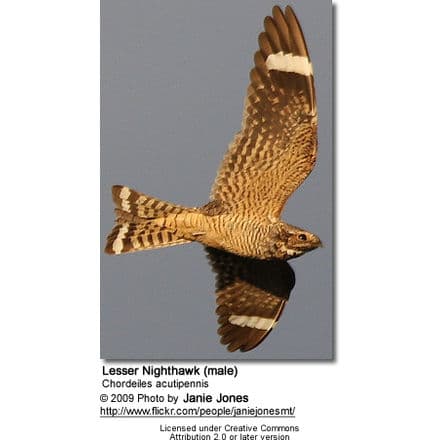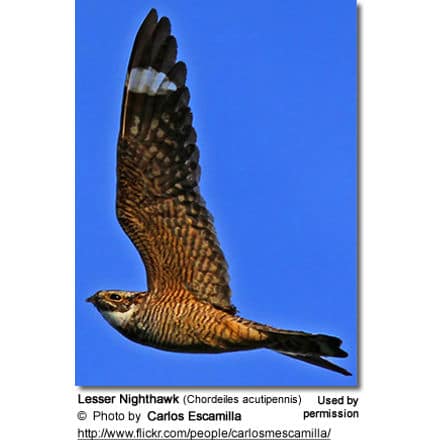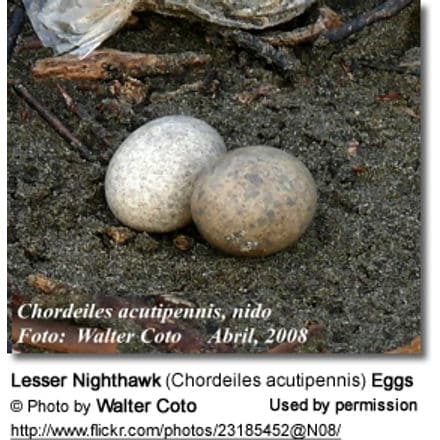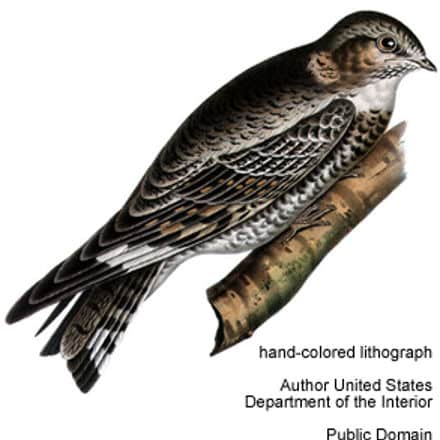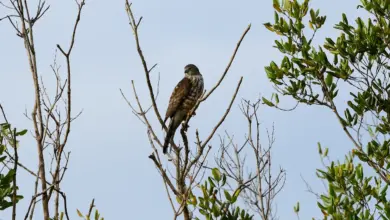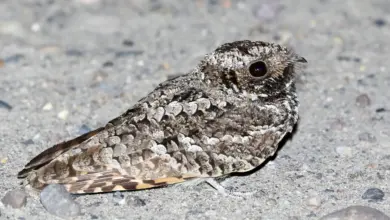Lesser Nighthawks
The Lesser Nighthawks (Chordeiles acutipennis) is also known as the San Lucas Nighthawk, Sharp-winged Nighthawk, Texan or Texas Nighthawk, and Trilling Nighthawk.
It occurs naturally in the American Southwest and much of Mexico south to South America.
This nightjar is commonly heard within its range, but less often seen – due to its nocturnal habits. The grey-brown mottled plumage keeps it well camouflaged as it blends perfectly into their habitat making this bird very difficult to spot during the daytime when it is usually hidden away sleeping.
They are most easily detected at night when light from car headlights is reflected ruby-red from their eyes, as they are sitting on tracks or roads. However, their presence is most often made known by their loud calls given at dusk.
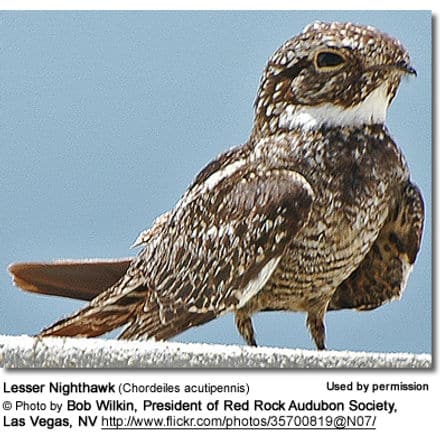
Alternate (Global) Names
Chinese: ????? … Czech: lelek menší, Lelek ostroocasý … Danish: Gråvinget Nathøg … Dutch: Texasnachtzwaluw, Texas-nachtzwaluw … Estonian: välja-videvikusorr … Finnish: Harmaahaukkakehrääjä … French: Engoulevent minime, Engoulevent ronronneur … German: Texas Nachtschwalbe, Texasnachtschwalbe … Guarani: Akuku, Guyra ate’y … Italian: Caprimulgo-sparviero minore, Succiacapre minore … Japanese: koamerikayotaka … Norwegian: Trillenatthauk … Polish: lelczyk ostroskrzydly, lelczyk ostroskrzyd?y … Portuguese: bacurau, Bacurau-de-asa-fina, bacurau-de-bando … Russian: ????? ?????????? ???????, ????? ????? ??????? … Slovak: súmracník ostrokrídly … Spanish: Añapero Chico, Añapero Garrapena, Añapero Menor, Atajacaminos ala fina, Chotacabras Chico, Chotacabras Menor, Gallina ciega peruana, Pucuyo menoro … Swedish: Mindre falknattskärra

Distribution / Habitat
In the United States, Lesser Nighthawks are found along the southern border of the American Southwest from south-central Texas to California, southern Nevada, around the Sacramento and Joaquin Valleys in California. They are rare visitors to the United States Gulf Coast states to Florida. The only other nighthawk in part of its range is the Common Nighthawk and those two are often confused.
Their breeding range extends south into Baja California (Mexico), through Mexico to Central America and South America.
Those breeding in the United States and northern Mexico move south to winter in southern Mexico and Central and South America. Single birds in particular may reside year-round within their native range.
In the mornings and evenings, they often congregate at bodies of water. They are mostly inactive during midday and hunt at night.
The Lesser Nighthawks is native to:
Aruba; Belize; Bolivia; Brazil; Canada; Chile; Colombia; Costa Rica; Ecuador; El Salvador; French Guiana; Guatemala; Guyana; Honduras; Mexico; Netherlands Antilles; Nicaragua; Panama; Paraguay; Peru; Suriname; Trinidad and Tobago; United States; Venezuela
They are occasional visitors / vagrants to:
USA: Alaska, Colorado, Oklahoma, Ontario, West Virginia; and Bermuda islands – off the east coast of the United States
Subspecies and Distribution:
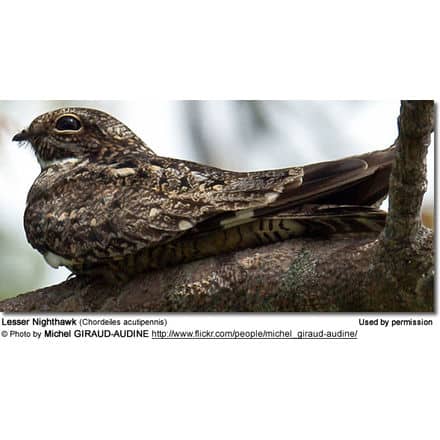
- Chordeiles acutipennis acutipennis (Hermann, 1783) – Nominate Race
- Range: Occurs in Colombia east through Venezuela, Trinidad and Tobago and the Guianas; south through Brazil, although absent from many parts of Amazonia, to northern Bolivia. May also be found in Paraguay.
- Chordeiles acutipennis texensis (Lawrence, 1856)
- Range: Southwestern USA south to central Mexico.
- Chordeiles acutipennis micromeris (Oberholser, 1914)
- Range: Northern Yucatán Peninsula, Mexico.
- Chordeiles acutipennis littoralis (Brodkorb, 1940)
- Range: Southern Mexico south through Central America to Costa Rica. May also occur in Panama.
- Chordeiles acutipennis crissalis (A. H. Miller, 1959)
- Range: Southwestern Colombia.
- Chordeiles acutipennis aequatorialis (Chapman, 1923)
- Range: Western Colombia, western Ecuador. May also occur in northwestern Peru.
- Chordeiles acutipennis exilis (Lesson, 1839)
- Range: Western Peru. Occasionally in extreme northern Chile.
Description
The Lesser Nightjar averages 8 – 9.2 inches (20 – 23 cm) in length, including its tail. Its wingspan is about 21 inches (53 cm). Like other nightjars, it has a very short bill.
The mostly grey, brown, white patterned plumage and cryptic markings allow them to blend perfectly into their surroundings. Their upper plumage and chest is patterned brown, grey and white. The plumage below is mostly brown with fine black horizontal streaking.
Dark bars can be seen on the plumage below. The wings are dark with a pale bar about 2/3 of the way out from the bend of the wing that can be seen in flight. The tail is dark with white barring.
The male can be identified by the white throat.
The female has a light-brown (buff) throat instead and she has buff spots on the inner primaries (= longest wing feathers). The band on the tail is either reduced or absent.
Immature birds have a uniformly buffy-grey upper plumage with fine dark markings and spots.
Similar Species:
It resembles the Common Nighthawk and Antillean Nighthawk, but is a little smaller in size and the wing patches are closer to the wing tip. The Lesser Nightjar also has a less deeply forked tail. The Lesser Nighthawk’s wing tips are slightly less pointed than those of the Common Nighthawk and Antillean Nighthawk.
The three species can be identified by their different vocalizations.
Calls / Vocalization
The Lesser Nighthawks is usually silent and is mostly heard in the spring and summer (breeding season) – often near breeding areas. It usually vocalizes at dawn and dusk (twilight).
The male’s call is described as a rapid, trilling, low whistled melodious trill, lasting several seconds. During the flight display, the male’s call is a bleating bao-b-bao-bao.
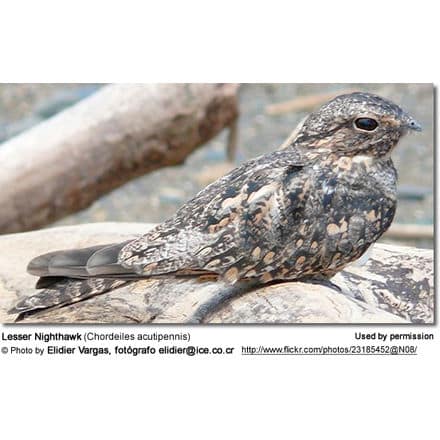
Breeding / Nesting
The Lesser Nighthawks arrive in their breeding territories between early March to mid-May, with most of them arriving in April. They migrate south to their wintering territories early August to late October, with most leaving between mid-August to mid-September.
The male establishes his territory and sings at night to keep rivals away and at the same time to attract a female.
Nightjars don’t actually construct a nest, as most other bird species do. They simply place the eggs on the ground on open soil or the roof of a building.
Nesting appears to be timed in such a way that the moon is more than half full at the time they are feeding their young – likely as the additional light during the night facilitates caring for the young and foraging for food.
The female may lay one to two spotted grey eggs (mostly two). During the day, the incubation of the eggs is undertaken by the female, while both parents share the incubation at night. The incubation period is about 18 to 19 days.
As the hatchlings emerge from the eggs, their skin is covered in down. Within 24 hours of hatching, they are able to move short distances. Generally they move apart shortly after hatching or paents shove them apart with their feet as they flush from the nest – this is probably to make it more difficult for predators to spot them.
The male defends the nest and the young against intruders.
Throughout the day, he will often hoover in place near the nest in a nearly vertical position, with his tail spread showing off his white barring. The parents communicate with their chicks by making soft clucking sounds to which the chicks respond.
The chicks are fed regurgitated food (usually insects) by both parents, who will also continue to brood their young until fledging, which generally occurs when they are about 20 to 21 days old.
If conditions are favorable, the female may lay a second clutch close to the first and while she is incubating the new set of eggs, the male continues to care for the young from first brood.
They have developed several behavioral adaptations to minimize predation:
- Their nocturnal (night) lifestyle reduces the likelihood of being detected by daytime predators. During the daytime, they typically sleep on the ground where they are perfectly camouflaged by their “earthy” colored plumage. They almost always change their roost sites on a daily basis.
- When nesting, they sit quietly on the eggs, minimizing any movements that could get them detected.
- If an intruder does get close to the nest, the parents may try to lead them away by first flushing off the nest and when landing feigning injury as they lead the potential thread away from the nest. While the parent performs this distraction display, the young may scatter and freeze.
- The parent who is not incubating the eggs or brooding the young will roost away from the nesting area.
- They may also move the eggs or young to prevent them from being preyed upon.
- Nightjars avoid voicing when they hear the calls made by predatory nocturnal animals, such as owls.
